Sweet potatoes are a versatile and nutritious root vegetable that is easy to grow. In this post, you will learn how to grow them in containers or raised beds for an epic harvest.
Although we tend to place sweet potatoes in the same category as white-flesh potatoes like Russet and red potatoes, they are unrelated botanically. Instead, the delicious orange tubers are members of the morning glory family while the more traditional white-flesh potatoes are members of the nightshade family.
Sun, Soil, Water, and Fertilizer
Sweet potatoes thrive in warm weather. They require a long growing season in full sun. If you live in a hot, arid region, sweet potatoes can benefit from a little afternoon shade
Unlike white potatoes, which are grown from seed potatoes (cured pieces of potato that have sprouted eyes), sweet potatoes are grown from slips, which are shoots or vines that have sprouted from mature sweet potatoes and then rooted in water. Slips can be purchased from seed companies or plant nurseries, or you can easily grow your own. I show you two methods for growing your own slips in this helpful article.

This article contains affiliate links. If you make a purchase using one of these links, I will receive a very small commission at no additional cost to you, and it will help me maintain this website. Rest assured, I only recommend products I actually like!
Three to four weeks after your area’s last spring frost date, when the soil is about 65oF (18o C), plant the sweet potato slips in well-draining, slightly acidic soil (pH of 5.0 to 6.5). If you are planting in raised beds, work the soil to a depth of 8 to 10 inches and remove any rocks, roots, etc. that might hamper a sweet potato’s development. If planting in containers (they will need to have good drainage) or fabric grow bags, choose ones that have at least a 5 gallon (19 liter) capacity and preferably 10 gallon (38 liter). These are the bags that I use to grow mine. Fill the containers or grow bags with loose potting mix.
In raised beds, space the slips 12 to 18 inches (30 to 46 cm) apart and about 4 to 6 inches (10 to 15 cm) deep, making sure the roots are covered with soil. If planting in rows, space the rows about 3 to 4 feet (1 to 1.2 meters) apart. If planting in a container or grow bag, place three to four slips per 10 gallon (38 liters) container or grow bag.
Water the slips well with a liquid organic fertilizer that is higher in phosphorus than it is in nitrogen, like this one. (A fertilizer that is higher in nitrogen will only promote vine and leaf growth and not root or sweet potato development.) Reapply the fertilizer once a month or every two weeks if growing in containers.
Sweet potato vines are sensitive to frost so if the forecast predicts an unexpected frost or freeze, be sure to cover the slips with a plant blanket or row cover.
On occasion, a sweet potato may grow up through the surface of the soil. If that happens, cover it back up with dirt, otherwise, the skin will turn a greenish tint, and the potato will taste bitter and may cause stomach upset if eaten.
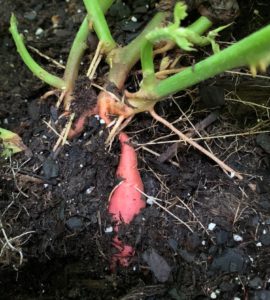
As the slips mature, be sure to remove weeds that pop up as these will compete with the sweet potato vines and roots for space and nutrients. Of course, one of the many benefits of growing in containers is that you do not have to weed!
Sweet potatoes prefer moist soil but can tolerate the top inch or two of soil drying out in-between waterings. Do not overwater as this will promote root rot and cause the potatoes to remain small and underdeveloped. Instead, deep and consistent watering is best. If growing in containers, you will need to water them more frequently.
Flowers and Vines: To Prune or Not to Prune?
Sweet potatoes produce beautiful trumpet-shaped flowers that resemble morning glories, which is not surprising since they belong to the same family. Some gardeners recommend removing the flowers from the vines, reasoning that it redirects the nutrients and energy back into the roots. On the other hand, some report that allowing the flowers to bloom will not affect the potatoes’ growth. I strike a happy medium, removing some of the flowers while allowing others to fully bloom. That way the pollinators and I can enjoy them, and the potatoes will still grow abundantly!

The vines should not be pruned as the leaves play a vital role in the plant’s photosynthesis and root development. The more sunlight the leaves synthesize, the larger the sweet potatoes will grow. If you are growing sweet potatoes in an area that has limited space, or if you are growing them in containers, resist the temptation to prune the vines and trellis them instead.
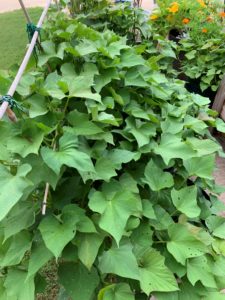
How and When to Harvest
About 90 to 120 days after planting the slips, the vines will start to turn yellow and wither, signaling it is time for the harvest. Stop watering the plants so the soil will dry out and so that the potatoes don’t split.
On harvest day, cut back the vines and gently dig through the soil with your hands or carefully use a trowel if necessary. (Be sure to save the vines for the compost pile!) The skin on the potatoes is soft and thin at this point so you should avoid nicking the potatoes. Gently remove any clumps of dirt by hand but do not wash the potatoes as it could damage the skin and shorten their shelf life.
Do not wait until your first fall frost to harvest the tubers as they could be damaged by the cold temperatures.

How to Cure Sweet Potatoes
Sweet potatoes need to be cured before they can be eaten or stored. The process helps toughen the skin for better storage and allows the starch in the potatoes to convert to sugar, hence the name sweet potato!
To cure sweet potatoes, lay them in a single layer in a tray or box, or on a shelf. Place them in a humid area with a temperature around 80o F (27o C) for about two weeks. Afterward, look through the potatoes and throw away any that are soft or look bad. Store the cured potatoes in a cool, darkened room for 4 to 6 months. You may want to save a few small potatoes to make slips for the following season.

Do not wash cured sweet potatoes until you are ready to eat them because it will shorten their shelf life. Additionally, do not store uncooked sweet potatoes in the refrigerator as the cold temperature will cause the center to harden and the taste will be negatively affected. The exception would be if you have cut and peeled a sweet potato in preparation for a dish and just need to store it in the refrigerator for a short time.
Diseases
Sweet potatoes can develop a variety of fungal diseases like black rot, which is characterized by dark, dry lesions, or Fusarium wilt, and verticillium wilt, which rot the plants’ stems. All three of these diseases are untreatable and can devastate an entire crop. Scurf, on the other hand, is a fungal disease that produces grey to dark brown patches on the skin. Lesions may continue to spread in storage. While it is unsightly, in the early stages, it can be scraped off and the potato consumed. You can learn more about scurf in this helpful article.

Scab is a common fungus in most soils. It is exacerbated when the soil is too dry and too alkaline (higher than a pH of 5.5). Scab is characterized by brown, woody scabs that form on the surface of the potato. Crops that have been affected by scab are still edible when the fungus is only skin deep. Scab can generally be avoided with proper watering and by making sure the soil is somewhat acidic.
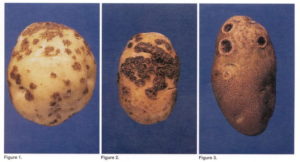
Sweet potatoes can also be targets for bacterial diseases such as bacterial soft rot, which produces brown to black water-soaked lesions on stems and can cause vines to wilt and the plant to die.
Crop rotation and maintaining good garden hygiene, like sanitizing containers and disinfecting garden tools, can help prevent the spread of fungal and bacterial diseases.
Pests
As it turns out, several pests love sweet potatoes as much as you do. Aphids (which spread a virus called potato leaf roll), whiteflies, flea beetles, cutworms, tortoise beetles, root knot nematodes, and sweet potato weevils, are some of the insects you may meet in your potato patch. Follow the links to learn how to manage these pests organically.
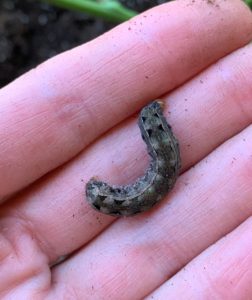
Varieties
There are many great varieties of sweet potatoes to choose from. If you are growing in containers or grow bags, you may be interested in growing a compact or bush variety, like Bush Porto Rico, which has copper skin and orange flesh, and Vardaman, which has golden skin and red-orange flesh. Jewel, a semi-bush type, is a popular choice. Garnet and Covington are both popular vining type sweet potatoes.
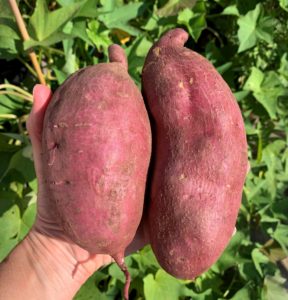
If you are looking for cultivars that have a shorter growing time, you might be interested in Beauregard (100 days), Centennial (90 days), or Georgia Jet (90 days). These are well-suited for northern climates that have a shorter growing season. If you are looking for something different, be sure to try the Japanese Murasaki variety. They have purple skin and white flesh.
If you are thinking about growing yams, you may be surprised to find out that, even though the terms are used interchangeably, yams and sweet potatoes are not botanically related. You can learn more about their differences and similarities in this interesting article.
Sweet potatoes may take a little longer than some crops to mature, but in the end, the harvest makes it worth the wait! If you have not tried growing these delicious tubers, I encourage you to save space in the garden for at least a grow bag or two.
Thank you for reading this article! If you found it helpful, please consider sharing it with others via email and social media!
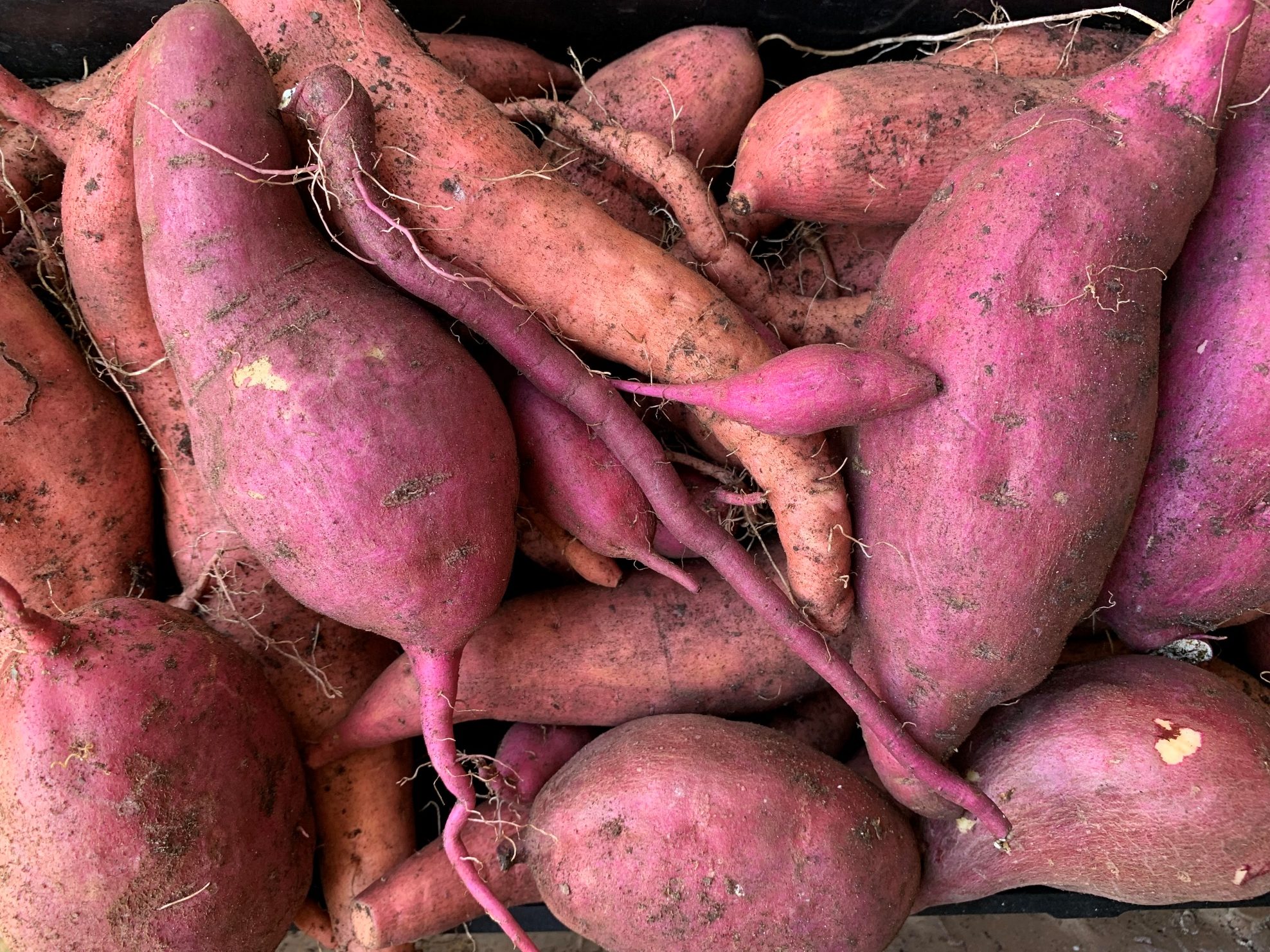



Thank u for this great tutorial 💙~
You’re welcome! 🙂